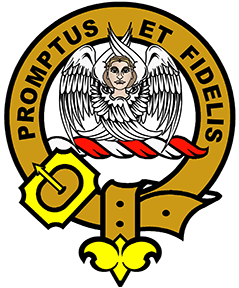Carruthers Clan
Carruthers Clan Crest: A seraphim volant Proper
Carruthers Clan Motto: Promptus et Fidelis (Ready and Faithful)
Carruthers Clan History: Carruthers is a topographical name taken from an ancient parish in Annandale, Dumfriesshire in the old West March. The name hails from an ancient Brythonic fort called Caer-Ruthers in the old Cumbric language. Progressively the landowners of that land and those living upon it, became known as Carruthers.
The first records of the name was William of Carruthers in the reign of Alexander II (1198-1249), who gave a large donation to the Abbey at Newbattle. It was his son, Simon, parson of Middlebie who signed the Ragman Roll in 1296. Carruthers were Foresters and Stewards of Annandale, Guardians of the Old Kirk Ford at Hoddom and Keepers of the Trailtrow Preceptory.
In 1320, for services to the Bruce, a charter of lands was given to William’s great grandson Thomas by Robert king of Scots, and the chiefly house of Carruthers of Mouswald began. These lands were enlarged by further charters from King David II in 1349. Thomas’s second brother John, progenitor to the current chiefly line of Holmains was the Kings Chancellor for Annandale in 1349, while his youngest brother Sir Nigel was the Chamberlain to the Regent was killed at the battle of Durham in 1346.
Carruthers of Mouswald flourished, becoming a barony in 1452 as the estates continued to grow. Nigel Carruthers was the Canon of Glasgow in 1419, John 6th of Mouswald, 1st Baron was Captain of the Royal Castle of Lochmaben, and his grandson, Sir Simon then Warden of the West March, fell at the battle of Kirtle for the Scottish crown in 1484 along with his brother Archibald, 7th of Mouswald.
Carruthers were one of the 17 Border Reiver Clans mentioned in the 'Suppression of Unruly Clans' Act of 1587 and it was during a border raid in 1548 that Sir Simon Carruthers, last of the House of Mouswald was killed. The chiefship then passed to the next in line, John Carruthers 5th of Holmains. John’s eldest son and heir fell at the battle of Solway Moss, and his second son George, Captain of Threave Castle took over the mantle as chief. Holmains became a barony in 1542.
In 1563 a feud broke out between Carruthers and Kirkpatrick of Closeburn, when their chief was wounded and several slain, however it was amicably settled within the year. In 1672, after the Lyons Act came into force, two Carruthers arms were registered, those of James 9th of Holmains, which are recognised as the chief’s arms and those of his cousin James of Isle, Chamberlain to the Earl of Annandale. The explorer Douglas Carruthers (1882-1962) was great uncle to the current chief, while Francis 11th Dormont, a distant cousin, was Deputy Assistant Director of the War Office 1915-1919.
Financial disaster struck Holmains in 1772, and the chiefship went into dormancy after the death of John 12th in 1809. In 2019, 210 years later, a petition of proofs was accepted by the Lord Lyon from Dr Peter Carruthers of Holmains 22nd of his line, who was named Chief of the Name and Arms of Carruthers and granted supporters to his arms befitting his position. The Carruthers tartan, first registered by Dr George Carruthers with the Scottish Register of Tartans in 2017, was officially adopted by the chief as the official clan tartan in 2019.
Surname distribution within Scotland is widespread, but the highest concentrations remain in the borders and lowlands of the country from west to east.
Places of Interest: Mouswald, Little Dalton Kirk, Carrutherstown, Lochmaben Castle, Comlongon Castle, Threave Castle.

